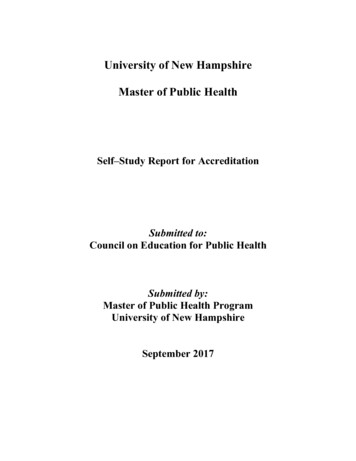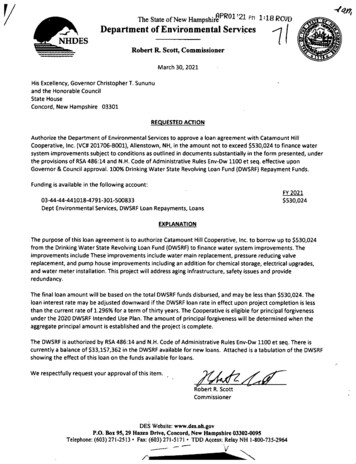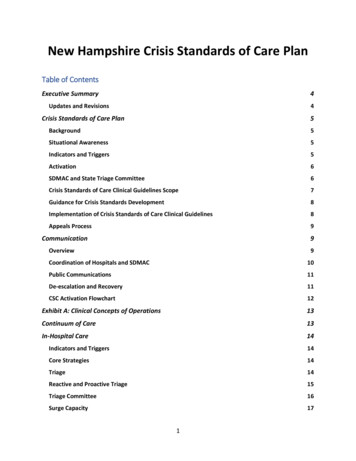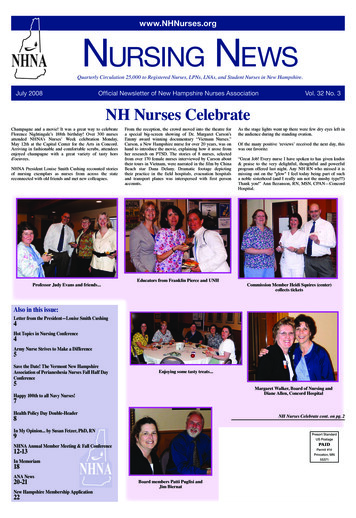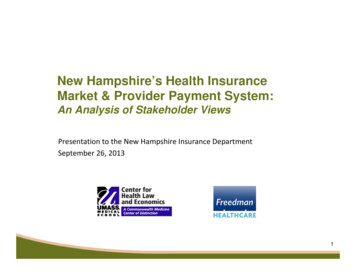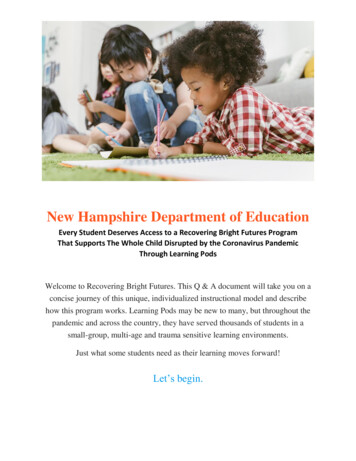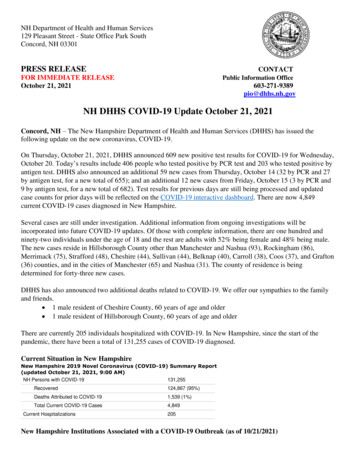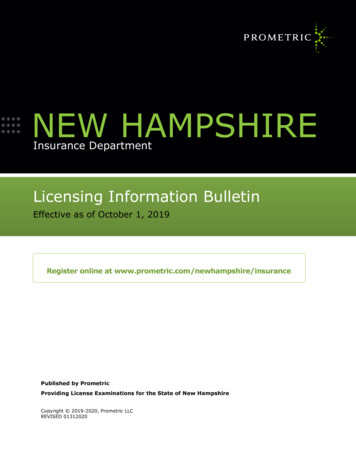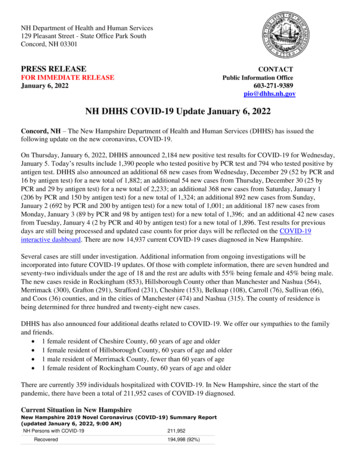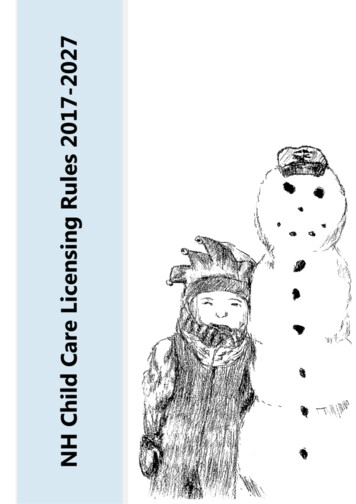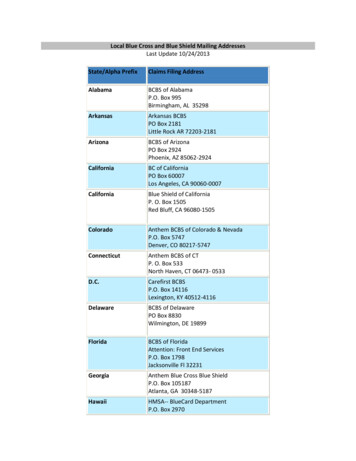
Transcription
STATE OF NEW HAMPSHIREGOVERNOR'SECONOMICREOPENINGTASKFORCE
Effective May 8, 2021, this document replaces all existing “Safer at Home 2.0” businessoperations guidance in place since March 2020. These Universal Best Practices arerecommendations for all individuals, businesses, and organizations to consider and implementfor the operation of their business. Nothing in this document or other guidance precludes anybusiness, organization, or individual business operators from taking additional precautions forthe health and safety of its employees and consumers.In addition to the best practices outlined here, businesses, organizations, and individualbusiness operators should review the following: Center for Disease Control and Prevention (CDC) guidance for COVID 19 New Hampshire Department of Health and Human Services (DHHS) COVID resourcepage Best Practices for Overnight Congregate Settings for Kids Long-Term Care Facilities (LTCFs) and Assisted Living Facilities (ALFs): U.S. Centersfor Medicare and Medicaid Services (CMS) guidance and NH DHHS guidance andresources for Long Term Care Facilities K-12 schools: NH Department of Education Grades K-12 Back-to-School Guidance andrecent public health guidance discussed and shared with schools. Residential Schools, Colleges and Universities: NH DHHS Recommendations forResponding to COVID-19The Continued Importance of Layered Protective MeasuresThere is no single intervention that will stop spread of COVID-19, especially because thecoronavirus can infect people and be spread both from people with symptoms of COVID-19(including people who may only show very mild symptoms), and from people without anysymptoms (“asymptomatic”). Therefore, implementing multiple layers of protection (i.e.,layered mitigation measures) will be most effective at stopping COVID-19 from spreading(see Swiss Cheese Model graphic below).1
(Image from Dr. Ian Mackay at virologydownunder.com)The same general steps and actions to control the COVID-19 virus that have been usedthroughout this pandemic continue to be important and recommended, including thefollowing:1. Good planning and communication to staff and consumers2. Vaccination against COVID-193. Identifying and excluding people with symptoms of COVID-19 or risk factors forexposure4. Testing people with symptoms of, or risk factors for, COVID-195. Social/physical distancing6. Face mask use7. Cohorting (i.e., grouping individuals together and keeping them together)8. Modifying layouts and limiting group sizes9. Good and frequent hand hygiene10. Cleaning and disinfection of frequently touched surfaces and avoiding sharedobjects11. Increasing and improving room and building ventilation (ventilation involvesreplacing stagnant indoor air that may contain peoples’ respiratory droplets withnew fresh outdoor air)12. Contract tracing, isolation, and quarantineThese Universal Best Practices have been re-organized into topic-based sections below forindividuals, businesses, and organizations to apply in layers.2
Best Practices: Preventing the Spread of COVID-191. Planning and Communication: It is important for business and organizations toconsider developing COVID-19 protection policies and process that help prevent theintroduction and spread of COVID-19 within an organization or business. It is alsohelpful to set expectations and clearly communicate those expectations to staff, visitors,attendees, customers, etc.a. This document can assist in developing organizational and workplace policiesand processes aimed at preventing the introduction and spread of COVID-19.b. A communication plan can educate all persons about the health and safetypractices and expectations. Such communication plans can include, but not belimited to, online methods (e.g., website, social media sites), email, otherelectronic communication such as reservations or confirmations, and printmaterials and mailings to the customers.2. Vaccination against COVID-19: There are currently three different COVID-19 vaccinesauthorized for use in the U.S., including the Pfizer-BioNTech, Moderna, and Johnson andJohnson (J&J) Janssen COVID-19 vaccines. All three vaccines are safe and highlyeffective. Vaccination is one of the most important things that your staff, visitors, andcustomers can do to protect your business, organization, and the surroundingcommunity. A person is considered “fully vaccinated” when they are at least 14 daysbeyond completion of a recommended COVID-19 vaccine series.a. Having a high employee vaccination rate will help protect your businessoperations in the event that someone with COVID-19 is identified to haveexposed staff, visitors, or customers at your organization or business, becausepeople who are fully vaccinated and remain without symptoms (i.e., are“asymptomatic”) are not required to quarantine after an exposure (although theyshould still follow other protective measure, including social distancing and facemask use).b. Consider providing paid time off, or other incentives, for employees to getvaccinated against COVID-19.3. Identifying and Excluding People with COVID-19, Symptoms of COVID-19, or RiskFactors for Exposure to COVID-19: Identifying people who have, or might have,COVID-19 is important to protect your business and organization. One of the first “linesof-defense” to prevent introduction of COVID-19 is to identify people who might haveCOVID-19 and recommending testing. Screening questions have been outlined in the NHDPHS Employer Travel, Screening, and Exclusion Guidance to assist in identifyingpeople who might have signs/symptoms of COVID-19 or risk factors for exposure.3
a. Consider active screening or daily self-attestation of staff and volunteers eachday before work for fever, symptoms of COVID-19, or risk factors for exposure,especially for those who provide services requiring close prolonged contactbetween staff and customers (people are within 6 feet of each other for 10minutes or longer).b. Establish a process where all staff, volunteers, visitors, customers, etc. areinformed and proactively educated that they should stay home if they meet anyof the screening questions outlined in the NH DPHS Employer Travel, Screening,and Exclusion Guidance,c. Consider developing employment policies that are supportive of employees whomay need to stay home because of new or unexplained symptoms of COVID 19and have yet to be tested.4. Testing for COVID-19: Testing for COVID-19 is one important measure to determine ifsomeone has COVID-19 so that others can be identified and others can be notified oftheir potential risk of developing infection in order to stop COVID-19 from spreading.There are two general types of testing: “diagnostic” testing and “screening” testing.Diagnostic testing involves testing people with signs or symptoms of COVID-19, ortesting asymptomatic people with an identified risk factor for exposure. Screeningtesting involves testing asymptomatic persons who do not have a known or suspectedexposure to COVID-19 for the purposes of early identification. Diagnostic testing isuniversally recommended. Screening testing can be adopted by business andorganizations, if desired, but it is also recommended to be implemented in certain highrisk congregate living situations (including long-term care facilities, residential schools,and overnight summer camps).a. Any person with new or unexplained symptoms of COVID-19 (even new mildcold symptoms) should be evaluated for COVID-19 testing using a PCR orantigen-based testb. Any person who is identified as a “close contact” to another person withCOVID19 should also be tested for COVID-19 as outlined in the NH DPHSguidance on self-quarantine after an exposure.c. Screening testing should be implemented in congregate living settings that arehigh-risk for transmission in order to prevent introduction and spread of COVID.a. People who are fully vaccinated (i.e., at least 14 days or more beyondcompletion of a recommended COVID-19 vaccination series), or who arewithin 90 days of a previously diagnosed COVID-19 infection can beexempted from participation in screening testing programs(asymptomatic testing), unless otherwise required to be tested by federalregulators (e.g., CMS requirements for long-term care facilities).4
5. Social/Physical Distancing: The coronavirus that causes COVID-19 is spread throughclose prolonged contact to an infected person’s respiratory droplets that are exhaledwhen a person breaths or talks. Spread of COVID-19 over longer distances is possible,especially when there are activities which can increase the production of smallerrespiratory droplets (called aerosols) that can remain suspended in the air and travelfurther distances. This risk can be minimized with combined use of physical distancing,face mask use, and increasing a building/room ventilation (discussed below). Here aresome practices to consider:a. Capacity can be limited to the number of people where physical distancing ismaintained between individuals or groups of related household contacts whileseated and during transit through the facility. If a business or organizationchooses to develop processes that allow un-related people to be closer than 6feet from each other than additional layers of protection can be considered(avoid moving about, hold event outdoors, consider face coverings, etc)b. Work to maintain a distance of at least 6 feet or more of physical separationbetween people or related groups when possible.c. Customers visiting bars and restaurants should stay seated as much as possibleto prevent close contact between customers.d. In certain situations where there may be increased risk of respiratory aerosolproduction and risk of further spread of COVID-19, physical distancing betweenpeople is suggested to be 8-10 feet, including during any group activities thatinvolve forced and heavy breathing indoors (e.g., indoor group fitness classes),singing (chorus/choir), or wind instrument playing (band performances).e. Physical distancing on buses and transportation vehicles can be challenging andoften 6 feet of physical separation is not possible, consider additional layers ofprotection such as face mask use, increasing outdoor air ventilation, assignedseating, etc.).6. Face Mask Use: Throughout the pandemic, face mask use has increasing been shown tobe an important measure for controlling the spread of COVID-19. The CDC hasestimated that at least 30% of people infected with the novel coronavirus areasymptomatic (do not have symptoms), but these individuals are still able to spread thevirus. Other people may be asymptomatic early in their infection but go on to developsymptoms days later. NH testing data in long-term care facilities has found similar ratesof asymptomatic infection. Therefore, face mask use is important to prevent spread ofCOVID-19 from people who are infected but may not be aware or have signs/symptomsof infection. Face mask use protects both the person wearing the mask, and othersaround that person in the event that they are asymptomatically infected. Consider thefollowing:.5
a. Encourage face mask use or both staff and customers who are required to bewithin 6 feet of each other (or other customers) for at least 10 minutes or longerfor delivery of service. If face masks need to be removed (e.g., for eating anddrinking), then people should ideally be separated by at least 6 feet. As analternative, other business process adaptations can be considered, such as ridgedplastic barriers between people who are separated by less than6 feet.b. Should they chose to, businesses, organizations and event organizers are able torequire employees, visitors, and customers wear face masks upon entering theirfacility or venue as a best practice but please keep in mind:i. Face masks should not be required for people who are under the age of2 years ii. Face masks should not be required for a person with a validmedical or developmental reason that prevents that person from wearinga face mask (see CDC guidance).c. Customers can be asked to wear face masks when entering and exiting a facilityor business, waiting in lines, buying tickets or food/drink, transiting through afacility/event, and in general when physical distancing is difficult to maintain.d. Face masks can also particularly important for staff caring for people who are athigh-risk for severe illness from COVID-19.7. Cohorting and Limiting Group Sizes: “Cohorting” involves creating small groups ofindividuals, keeping those individuals consistently together in one group, andpreventing interaction between people of different groups. Cohorting is an importantCOVID-19 control/mitigation strategy because if COVID-19 is introduced into onegroup, it limits spread ideally only to those within that one group, and prevents spreadbetween groups. This allows a business or organization to continue operations evenwhile some people may be required to quarantine due to an exposure. The other benefitof strict cohorting is that it potentially allows for relaxed restrictions within a groupwhere physical distancing or consistent mask use may not be able to be maintained dueto the prolonged duration of interaction between individuals (e.g., childcare agencies,day camps, overnight residential summer camps, etc.). The smaller the group sizing, themore protective the cohorting/grouping, but smaller groups may be less feasible forbusinesses. Additionally, cohorting may not be possible in all situations, so it should beapplied in the context of other layered mitigation measures. Keys to success cohortinginclude:a. Avoid mixing or interaction between groups. If staffing is an issue and staff arerequired to “float” between groups, then staff should be selected who are fullyvaccinated.6
b. If possible and staffing allows, larger groups should be separated into smallergroups.c. Ideally group sizes should be limited to 20 people or fewer, although exact groupsizes will vary depending on situation and local context.d. Social/physical distancing, face mask use, and other mitigation measures shouldstill be considered and implemented within the cohorting/grouping as feasible.8. Modifying Layouts and Processes: Business and organizations processes should bemodified to implement the layers of mitigation/protection outlined in this document.This section highlights the importance of thinking through business processes andlooking for ways to incorporate multiple layers of protection into processes. Here aresome practices to consider:a. Maintain unidirectional flow of customers to the extent possible (especially atlarger events), incorporate as much physical distancing into all businessprocesses as possible (including while waiting in lines), and avoid congregatingand groups gathering/loitering (including developing processes to avoiddevelopment of lines).b. Physical barriers (e.g., plastic or acrylic shields or barriers) should be placedbetween staff and customers at check-in/out, ticketing and other servicecounters.c. Modify employee and volunteer schedules to reduce the frequency and durationof physical interactions, including staggering shifts, breaks, and meals (maintaincompliance with wage and hour laws and other requirements).d. Arrange employee and volunteer work-space layout to allow for at least 6 feet ofsocial distancing when possible.e. Stagger any customer/client appointments, arrivals, drop-off, pick-up times, etc.to limit customer interaction to allow sufficient time for any needed cleaning anddisinfection between appointments when possible.f. Limiting waiting areas to avoid congregating and any waiting areas should haveseating for customers spaced at least 6 feet apart, while encouragingcustomers/clients to wear a face masks while in the waiting room.g. Avoid waiting lines when possible and provide demarcated spacing for people tostand/wait at least 6 feet apart.h. When possible, develop check-in and check-out processes that involve electronicor other non-touch options, including with financial transactions. Businessesand organizations can also take steps to limit self-service options. For example,consumer samples, communal packaging, food/beverages (e.g. candy dishes,common creamers at coffee stations).7
9. Hand Hygiene: Many different respiratory infections, including COVID-19, can bespread after an infected person touches their eyes, nose, or mouth (i.e., mucousmembranes) where viral pathogens can live and then spread to other people throughtouch, or contamination of commonly touched surfaces. While the risk of spreadingCOVID-19 from contaminated surfaces is believed to be low, it remains important toincorporate and promote frequent hand hygiene (regularly washing hands or usinghand sanitizer) into all business processes.a. Consider making alcohol-based hand sanitizer readily available to employees,volunteers, and customers/clients throughout the facility or event venue,including upon entry and exit to a facility, at check-in and check-out, in eatingareas, outside restrooms, etc.b. Promote frequent hand hygiene for employees, volunteers, and customers.c. For staff overseeing children, supervise and help young children to ensure theyare washing/sanitizing hands correctly. When soap and water are not readilyavailable and hand sanitizer is used with young children, it should be used underdirect supervision of staff.10. Cleaning and Disinfection and Avoiding Shared Objects:a. Employers should provide training to all employees about cleaning anddisinfection prior to assigning cleaning and disinfection tasks, and employersshould consider creating a checklist to guide cleaning and disinfectionprocedures.b. Use disposable gloves to clean and disinfect. Follow other instructions forpersonal protective equipment (PPE) use, contact time, etc. on product labels.Staff should wash hands after cleaning and disinfection occurs.c. Cleaning and disinfecting supplies should be made readily available by thebusiness.d. When disinfecting, use an EPA-approved disinfectant effective against the novelcoronavirus.e. CDC recommends that when no people with confirmed or suspected COVID-19are known to have been in a space, cleaning high-touch surfaces once a day isusually sufficient to remove virus that may be on surfaces. If a sick person, orsomeone with COVID-19, has been within a facility or space within the last 3days, then cleaning and disinfection of that space should occur. If more than 3days have passed since the person who is sick or diagnosed with COVID-19 hasbeen in the space, no additional cleaning (beyond regular cleaning practices) isneeded.f. Cleaning and disinfection of high-touch surfaces can be considered morefrequently than once a day, especially if there is high community transmission of.8
COVID-19, low mask compliance or poor hand hygiene, or if the space is used bypeople at increased risk for severe illness from COVID-19.g. Maintain other routine facility cleaning and disinfection procedures.h. Avoid shared objects, if possible.i. Clean and disinfect shared objects between use, especially if objects might becontaminated with a person’s respiratory secretions or saliva (e.g., toys inchildcare classrooms). At a minimum, ensure hand hygiene is practiced by allpersons before and after use of a shared object.i. Objects that are not able to be cleaned or disinfected (e.g., books, papers,etc.) can still be shared, if necessary, but focus should be on good handhygiene before and after use of shared objects.11. Improving Building, Room, and Space Ventilation: Evaluate ventilation systems toincrease room and overall building ventilation, including increasing the number of airexchanges with outdoor air, limit internal air circulation, improve central air filtrationor other upgrades to HVAC systems. CDC guidance on ventilation in buildings provideshelpful information for evaluating and improving building, room, and other spaceventilation. Ventilation is also important to increase in other non-building spaces, suchas on buses or public transportation – in such situations, a vehicle’s ventilation can beincreased by opening windows (if weather permits) or using the vehicles air system tobring in outdoor air and avoid re-circulating internal air. In enclosed spaces, improvingventilation should be combined with attempts to maximize physical distancing betweenpeople and face mask use.12. Public Health Contact Tracing, Isolation and Quarantine: “Contact tracing” refers tothe act of investigating who has been in close contact with a person diagnosed withCOVID-19 so that the person infected can be “isolated” and the people who have been inclose contact can be “quarantined” to reduce further spread of the virus. Contact tracing,isolation, and quarantine, should be a collaborative effort between the New HampshireDivision of Public Health Services (DPHS), Bureau of Infectious Disease Control (BIDC)and the business or organization where the COVID-19 exposure occurred.a. COVID-19 exposures at businesses and organizations should be promptlyreported to NH DHHS DPHS Bureau of Infectious Disease Control at 6032714496. Reporting of infectious diseases and furnishing requested infectiousdisease-related business information (including patron and employeeinformation) is a requirement under NH RSA 141-C.b. NH DPHS can provide assistance with contact tracing and guidance toprevent/control spread of COVID-19, including in outbreak situations.9
c. To assist with identifying “close contacts” of people with COVID-19, and to avoidthe need for possible public notification, it is recommended that businesses andorganizations maintain attendance / customer lists and seating charts, includinghaving assigned seating in situations where it’s feasible (e.g., buses, schoolclassrooms, etc.).10
for Medicare and Medicaid Services (CMS) guidance and NH DHHS guidance and resources for Long Term Care Facilities K-12 schools: NH Department of Education Grades K-12 Back-to-School Guidance and recent public health guidance discussed and shared with schools. Residential Schools, Colleges and Universities: NH DHHS Recommendations for
